Symbol Code: SM000042 Symbol Name: Sesa Wo Suban (Category: MORTALITY )
|
 | (Mortal Dust): “Change or transform your character”symbol of life transformationThis symbol combines two separate adinkra symbols, the “Morning Star” which can mean a new start to the day, placed inside the wheel, representing rotation or independent movement.
Reference: |
|
Symbol Code: SM000525 Symbol Name: Abraxas (Category: Mortality )
|
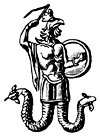 | (Mortal Battle): Abraxas, also known as Abrasax, is a Gnostic solar deity associated by the ancients with Yahweh, Mithras and the Celtic Belenus, as well as Yeshu (Jesus). Amulets and seals bearing the figure of Abraxas were common in the second century, and were used as recently as the thirteenth century in the seals of the Knights Templar. By medieval times, Abraxas was relegated to the ranks of demons.The image most associated with Abraxas is that of a composite creature with the head of a rooster, the body of a man, and legs made of serpents or scorpions. He carries a whip and shield, called wisdom and power, respectively. Abraxas is occasionally depicted driving a chariot drawn by four horses, which representing the four elements.
Reference:http://symboldictionary.net/?p=1020 |
|
Symbol Code: SM000526 Symbol Name: Garuda (Category: Mortality )
|
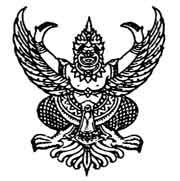 | (Mortal Battle): This Vedic solar deity is Garuda (Sanskrit, eagle), a mythological creature who is a half-man, half eagle hybrid. He is known as the king of the birds and destroyer of snakes. Garuda is likely the personification of the constellation Aquila (which is coincidentally named for the sacred eagle of Zeus).Garuda is the vehicle of the God Vishnu, and sometimes considered a manifestation of Vishnu himself.
Reference:http://symboldictionary.net/?p=1819 |
|
Symbol Code: SM000527 Symbol Name: Star and Crescent of Islam (Category: Mortality )
|
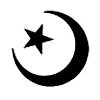 | (Mortal Battle): This emblem, commonly recognized as the symbol of the Islamic faith, has actually acquired its association to the faith by association, rather than intent.The star and crescent symbol itself is very ancient, dating back to early Sumerian civilization, where it was associated with the sun God and moon Goddess (one early appearance dates to 2100 BCE), and later, with Goddesses Tanit and even Diana. The symbol remained in near constant use, and was eventually adopted into the battle-standard of the Ottoman Dynasty, who are mainly responsible for its association with Islam. As the Dynasty was also the policitical head of the faith, it was inevitable that their symbol would be associated with Islam as well. It should be noted that there is no mention of such a symbol in the Koran, the Holy book of Islam, nor is there any relationship between the crescent and star and the Prophet (whose flag was black and white, inscribed “Nasr um min Allah,” “with the help of Allah.”)
Reference:http://symboldictionary.net/?s=battle |
|
Symbol Code: SM000528 Symbol Name: Chi-Rho (labarum, Constantine’s cross, Christogram, Monogram of Christ) (Category: Mortality )
|
 | (Mortal Battle): The Chi-Rho emblem can be viewed as the first Christian Cross.As a pre-Christian symbol, the Chi-rho signified good fortune. The Chi ro became an important Christian symbol when adopted by the Roman Emperor Constantine, representing the first two letters in the name of Christ- the Chi, or ‘ch,’ and Rho, or ‘r.’ According to Church Father Eusebius, on the eve of the Battle of the Milvan Bridge, the Emperor saw the emblem in a dream, with the inscription, “By this sign, you shall conquer.” According to the story, the battle was won. In return for the victory, Constantine legalized the religion and erected Christian churches.
Reference:http://symboldictionary.net/?s=battle |
|
Symbol Code: SM000529 Symbol Name: Victory Banner (Dhvaja) (Category: Mortality )
|
 | (Mortal Battle): The victory banner (dhvaja, flag) in Buddhism symbolizes victory of the Dharma over fear, ignorance, and death. The banner is drawn from Hindu religious symbolism, and is shared with the Sikh and Jain religions, after the standards carried into battle by military leaders. The emblems have similar meanings in all of these faiths; that is, the victory of doctrine over ignorance and evil. In Tibetan doctrine, specifically, the banner symbolizes victory over the four Maras, or great illusions, which bar the way to illumination: emotional defilement, lust, passion, and the fear of death.
Reference:http://symboldictionary.net/?s=battle |
|
Symbol Code: SM000530 Symbol Name: Fleur de Lis (Category: Mortality )
|
 | (Mortal Battle): The Fleur de Lis, also known as the “Lily of France,” has one of the most controversial histories of any symbol. Standard heraldic histories claim it originated in the tenth century as a symbol of sovereignty, and was later adopted as the emblem of French King Louis the VII. It is believed to take the shape of a lily or Iris, and to symbolize Mary and the Holy Trinity.In truth, the symbol is found much further back in history- as far back as Assyrian ornamental design, where it is most likely a representation of the tree of life. It is also seen on Greek, Roman, and Celtic coinage. In France, it’s use may date back to Merovingian King Clovis, who reportedly wore an Iris flower in his helmet as he rode to victory in battle. The symbol in Christian Europe is strongly linked to Mary, as the lily was a symbol of her purity.
Reference:http://symboldictionary.net/?s=battle |
|
Symbol Code: SM000531 Symbol Name: Celtic Animal Symbols: Birds (Category: Mortality )
|
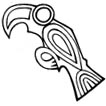 | (Mortal Battle): The Raven ravenBecause of their dark coloring and gruesome dietary habits, ravens were emblems war and death, and sacred to the gods and goddesses of the battlefield, most notably the warrior-god Bran and the war-goddess Morrigan. The raven acted as psychopomp, tasked with escorting the souls of the dead into the Otherworld. The ravens were sometimes viewed as the reincarnation of slain warriors and heroes.Due to their close relationship with the gods, ravens were used for divinatory purposes and considered quite literally as the voices of the gods- the Otherworld deities Lugh and Midir are both accompanied by pairs of magical ravens. (This symbolism is echoed in Norse mythology, where the raven is the messenger of the father-god Odin) Images of three interlinked ravens are emblems of the triple goddesses of sovereignty, particularly the Morrigan.
Reference:http://symboldictionary.net/?s=battle |
|
Symbol Code: SM000532 Symbol Name: The crane (Category: Mortality )
|
 | (Mortal Battle): The crane was sacred to early Celts, who left behind many votive images of the bird. Manannan Mac Lir, the Irish god of the sea, who had a magical bag made from the the skin of a crane who was his lover magically transformed. The underworld god Midir owned three cranes to guard his home, and to see three cranes is an omen of death. The crane was also an emblem of envy, and Irish legend has many stories of women transformed into cranes by rivals. The crane also features in Christian legends, where transformation into a crane is a common punishment for disrespecting a saint or as penance for a variety of sins.
Reference:http://symboldictionary.net/?s=battle |
|
Symbol Code: SM000533 Symbol Name: Celtic Animal Symbols: Boar (Category: Mortality )
|
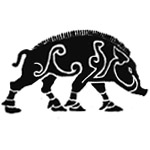 | (Mortal Battle): Wild boars are fearsome, dangerous animals, yet prized for their meat, a favorite game animal of the Celts. The boar is an emblem of fertility, fearlessness, and strength, but also stubbornness, war, and chaos. As the meat of the boar is prized, it is also a symbol of hospitality. Any function of importance would include a feast with boar meat (Nothing says “you’re an honored guest” like a tusk-wound!) as a central offering, and roasted boar meat (the remains thereof, at least) is a frequent find in the burial-places of tribal chieftains.
Reference:http://symboldictionary.net/?s=battle |
|
Symbol Code: SM000539 Symbol Name: Jain Hand (Ahimsa, Abhaya Mudra) (Category: Mortality )
|
 | (Mortal Forms): The emblem of the Jain religion, symbolizing its main tenet, the doctrine of nonviolence. The hand is in the position of the abhaya or “no fear” mudra, a gesture-symbol shared with Hinduism and Buddhism. The wheel in the center of the palm is the wheel of Samsara (or dharmachakra); the word in the center of the wheel reads ahimsa, “stop.”Together, they represent the halting of the cycle of reincarnation through the practice of Jain asceticism, the avoidance of harm to any living creature.
Reference:http://symboldictionary.net/?p=1834 |
|
Symbol Code: SM000540 Symbol Name: Golden Fishes (Suvarna Matsya) (Category: Mortality )
|
 | (Mortal Forms): The golden fishes are one of the eight auspicious signs in Buddhist iconography, wherein they represent joy, freedom, and fearlessness. In Vedic (Hindu) tradition, the fish is the first incarnation of the god Vishnu, two fishes together symbolized the sacred Ganges and Yamuna rivers, and later, the twin channels of ida and pingala, through which pranic energy moves through the body. In Chinese folk belief, a pair of fish are considered a lucky gift for married couples.
Reference:http://symboldictionary.net/?p=1780 |
|
Symbol Code: SM000541 Symbol Name: Akua’ba (Akwaba, African Fertility Doll) (Category: Mortality )
|
 | (Mortal Forms): An Akua’ba is a carved figure used by the African Ashanti tribe as a talisman to promote fertility and and to protect pregnant women.A woman who hopes to become pregnant will keep such a blessed doll on her person, and dresses and cares for it as one would a real child.
Reference:http://symboldictionary.net/?p=3077 |
|
Symbol Code: SM000577 Symbol Name: Symbols of Mortality (Category: Mortality )
|
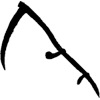 | The most common symbols of mortality were the grim reaper and his scythe, the death’s head, and the hourglass, all appropriated from icons of Greek and Roman Paganism. Slogans such as “remember death” and “all is vanity” were omnipresent- death was around the corner, and one had better repent if one was to avoid an eternity of damnation.
Reference:http://symboldictionary.net/?s=mortality |
|
Symbol Code: SM000578 Symbol Name: Gourd (Category: Mortality )
|
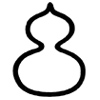 | The gourd is an ancient Taoist symbol of longevity and good health, but also a symbol of release. It is the emblem of Li Tie Guai, one of eight immortals of Taoist mythology. Li Tie Guai was a powerful magician who possessed not only the secret to immortality, but the ability to travel outside his body. Li carried the elixr of immortality in a gourd, which is an allegory for the body as the container of the soul. The gourd is known as the “precious gourd” in Feng Shui, and considered a receptacle of good fortune.
Reference:http://symboldictionary.net/?p=1651 |
|
Symbol Code: SM000579 Symbol Name: Vesica Pisces (Ichthys, Jesus Fish, Mandorla) (Category: Mortality )
|
 | This symbol, called the vesica pisces (piscis) or “Jesus fish,” has an unusual history. Used almost exclusively today to denote membership in the Christian religion, the symbol once held a very different meaning (even to the early Christians who adopted it). The word usually found inscribed within, IXOYE (Ichthus), is Greek, meaning fish. The emblem became significant to Christians after St. Augustine, who extracted the word from the acrostic prophecy* of the Erythraean Sibyl, and applied the kabbalistic technique of notarikon (acrostic) to the word to reveal “Jesus Christ, God’s son, savior.”
Reference:http://symboldictionary.net/?p=1127 |
|
Symbol Code: SM000580 Symbol Name: Celtic Animal Symbols: Dragons and Serpents (Category: Mortality )
|
 | The Celtic dragon and serpent were ancient symbols of fertility, wisdom, and immortality. A hybrid horned dragon/snake figure was connected to the torque collar, a symbol of kingship and status, and to the horned deity Cernunnos. The serpent was related to the dragon, and was connected with healing pools and springs. The Romans observed that the Druids especially revered the serpent for healing, and that they ascribed the same powers to the “serpent’s egg,” a particular sort of egg-shaped stone. A number of old tales feature magical treasure-guarding serpents who reside in wells- a common motif is the horned snake who guards a golden torque, a reference to divine authority.
Reference:http://symboldictionary.net/?p=917 |
|
Symbol Code: SM000581 Symbol Name: Panther Symbol (Category: Mortality )
|
 | The Panther symbol featured strongly in the Mississippian culture. The Panther was believed to be a supernatural deity who resided in the Underworld with the spirits associated with death and destruction. The Panther is seen as a malevolent being or monster who fights then devours his enemies and was strongly associated with warfare. These creatures, or monsters, were referred to as "water panthers". As monsters of the Underworld they were locked in a never-ending war with the supernatural creatures of the sky (the Upperworld). Their battles were responsible for earthquakes, tornadoes and thunderstorms, they were Masters of the Rain which is why they are called "water panthers".
Reference:http://www.warpaths2peacepipes.com/native-american-symbols/panther-symbol.htm |
|